189 years ago, the largest flood in the history of St. Petersburg occurred. In memory of this event, I will tell you about it and other deadliest floods in the world.
1. St. Petersburg flood, 1824
About 200-600 dead. On November 19, 1824, a flood occurred in St. Petersburg, which killed hundreds of human lives and destroyed many houses. Then the water level in the Neva River and its canals rose 4.14 - 4.21 meters above the normal level (ordinary).
Memorial plaque on the Raskolnikov House: 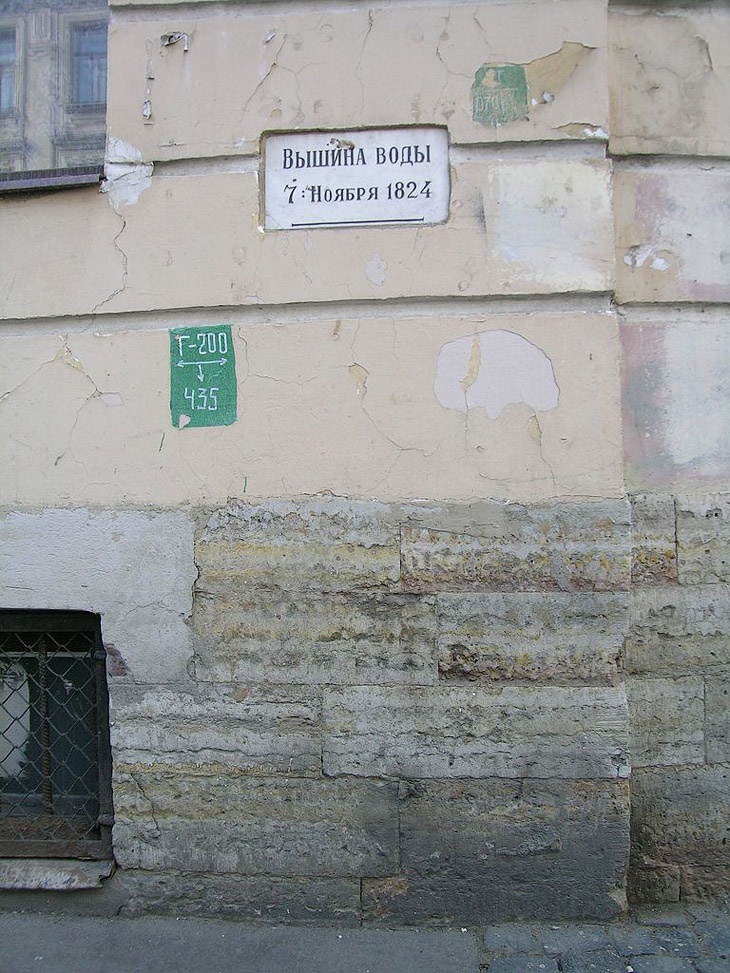
Before the flood began, it was raining and a damp and cold wind was blowing in the city. And in the evening there was a sharp rise in the water level in the canals, after which almost the entire city was flooded. The flood did not affect only the Liteinaya, Rozhdestvenskaya and Karetnaya parts of St. Petersburg. As a result, material damage from the flood amounted to about 15-20 million rubles, and about 200-600 people died.
One way or another, this is not the only flood that occurred in St. Petersburg. In total, the city on the Neva was flooded more than 330 times. In memory of many floods in the city, memorial plaques have been installed (there are more than 20 of them). In particular, a sign is dedicated to the largest flood in the city, which is located at the intersection of the Kadetskaya Line and Bolshoy Prospekt of Vasilievsky Island.
St. Petersburg flood of 1824. Author of the painting: Fyodor Yakovlevich Alekseev (1753-1824): 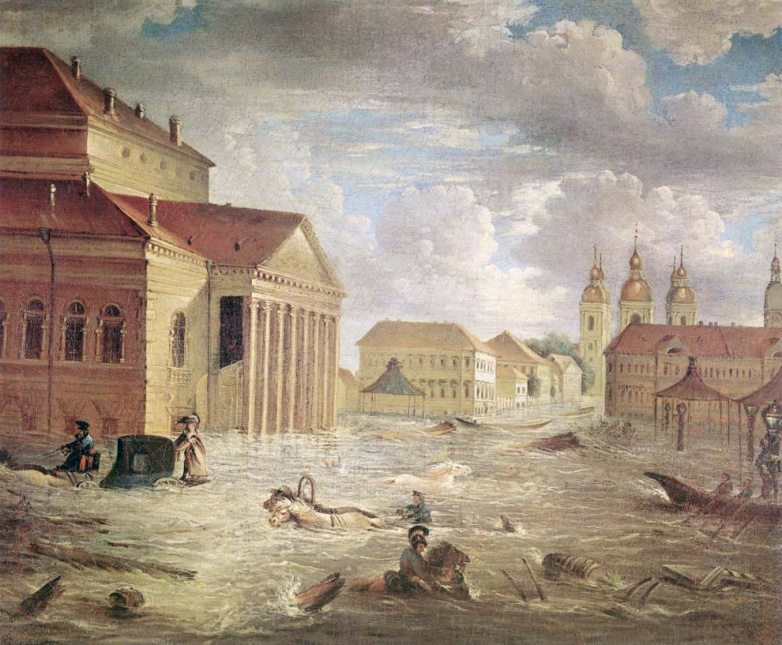
Interestingly, before the founding of St. Petersburg largest flood in the Neva delta occurred in 1691, when this territory was under the control of the Kingdom of Sweden. This incident is mentioned in Swedish chronicles. According to some reports, that year the water level in the Neva reached 762 centimeters.
2. Flood in China, 1931
About 145 thousand - 4 million dead. From 1928 to 1930, China suffered from severe drought. But at the end of the winter of 1930, strong snowstorms began, and in the spring there were incessant heavy rains and a thaw, which caused the water level in the Yangtze and Huaihe rivers to rise significantly. For example, in the Yangtze River the water rose by 70 cm in July alone. 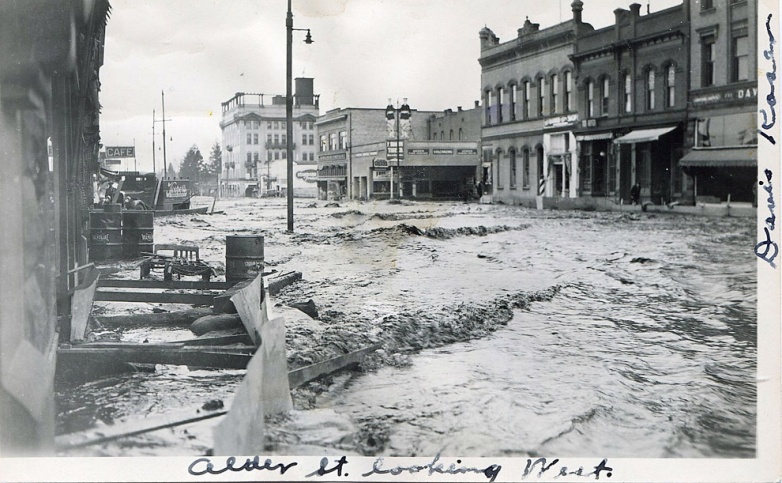
As a result, the river overflowed its banks and soon reached the city of Nanjing, which was at that time the capital of China. Many people drowned and died from waterborne infectious diseases such as cholera and typhus. There are known cases of cannibalism and infanticide among desperate residents.
According to Chinese sources, about 145 thousand people died as a result of the flood, while Western sources claim that the death toll was between 3.7 million and 4 million.
By the way, this was not the only flood in China caused by the waters of the Yangtze River overflowing its banks. Floods also occurred in 1911 (about 100 thousand people died), in 1935 (about 142 thousand people died), in 1954 (about 30 thousand people died) and in 1998 (3,656 people died). Considered the largest natural disaster throughout the entire documented history of mankind.
Flood victims, August 1931: 
3. Yellow River Flood, 1887 and 1938
About 900 thousand and 500 thousand died, respectively. In 1887, heavy rains fell for many days in Henan Province, and on September 28, rising water in the Yellow River broke the dams. Soon the water reached the city of Zhengzhou, located in this province, and then spread across the entire northern part of China, covering approximately 130,000 sq. km. Due to the flood, about two million people in China were left homeless, and approximately 900 thousand people died.
And in 1938, a flood on the same river was caused by the Nationalist government in Central China at the beginning of the Sino-Japanese War. This was done in order to stop Japanese troops rapidly advancing into central China. The flood was subsequently called "the largest act of environmental warfare in history."
Thus, in June 1938, the Japanese took control of the entire northern part of China, and on June 6 they captured Kaifeng, the capital of Henan Province, and threatened to capture Zhengzhou, which was located near the intersection of important railways Beijing-Guangzhou and Lianyungang-Xi'an. If the Japanese army had managed to do this, major Chinese cities such as Wuhan and Xi'an would have been under threat.
In order to prevent this, the Chinese government in Central China decided to open dams on the Yellow River near the city of Zhengzhou. Water flooded the provinces of Henan, Anhui and Jiangsu adjacent to the river.
Soldiers of the National Revolutionary Army during the flood on the Yellow River in 1938: 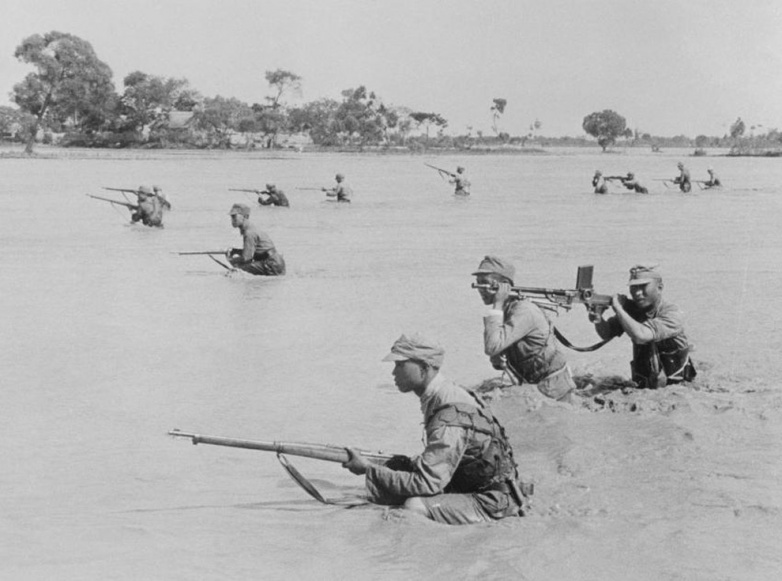
The floods destroyed thousands of square kilometers of farmland and many villages. Several million people became refugees. According to initial data from China, about 800 thousand people drowned. However, today, researchers studying the archives of the disaster claim that many died less people- about 400 - 500 thousand.
Yellow River Yellow River: 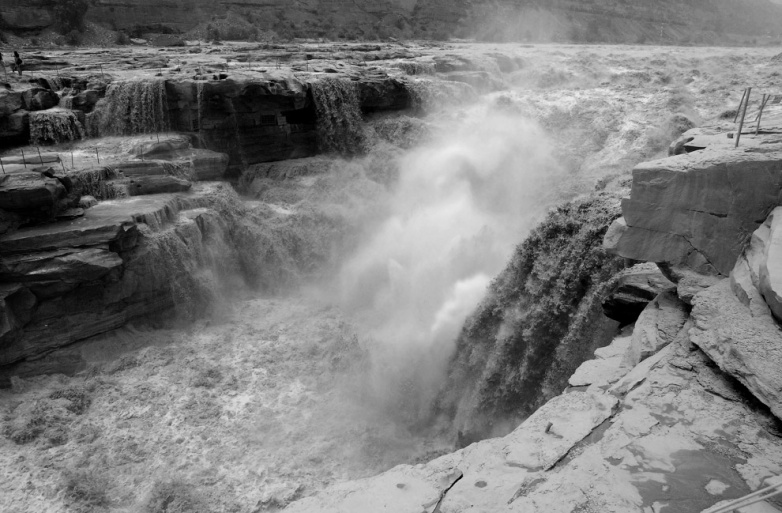
Interestingly, the value of this Chinese government strategy has been questioned. Because according to some reports, Japanese troops at that time were far from the flooded areas. Although their advance on Zhengzhou was thwarted, the Japanese took Wuhan in October.
4. Flood of St. Felix, 1530
At least 100 thousand dead. On Saturday November 5, 1530, the day of Saint Felix de Valois, most of Flanders was washed away, historical region The Netherlands and the province of Zealand. Researchers believe that more than 100 thousand people died. Subsequently, the day when the disaster occurred began to be called Evil Saturday. 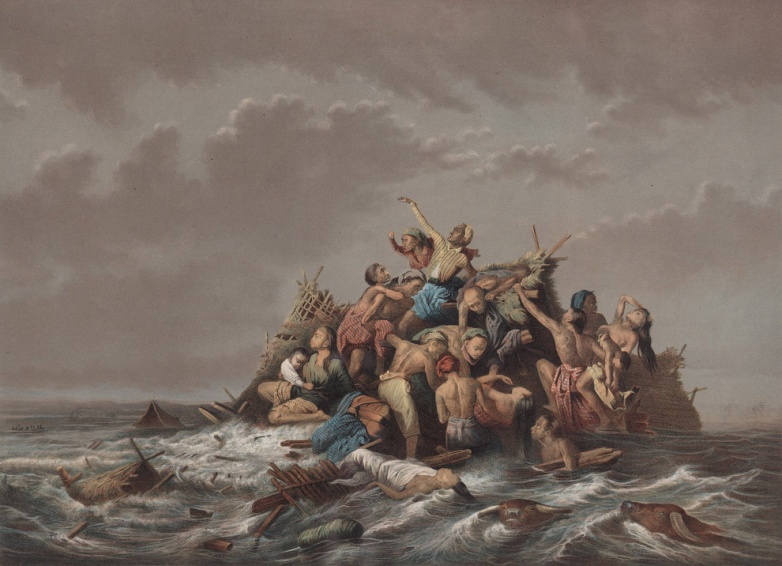
5. Burchardi flood, 1634
About 8-15 thousand dead. On the night of October 11–12, 1634, flooding occurred in Germany and Denmark as a result of a storm surge caused by hurricane winds. That night, dams broke in several places along the North Sea coast, flooding coastal towns and communities in North Friesland.
Painting depicting the Burchardi flood: 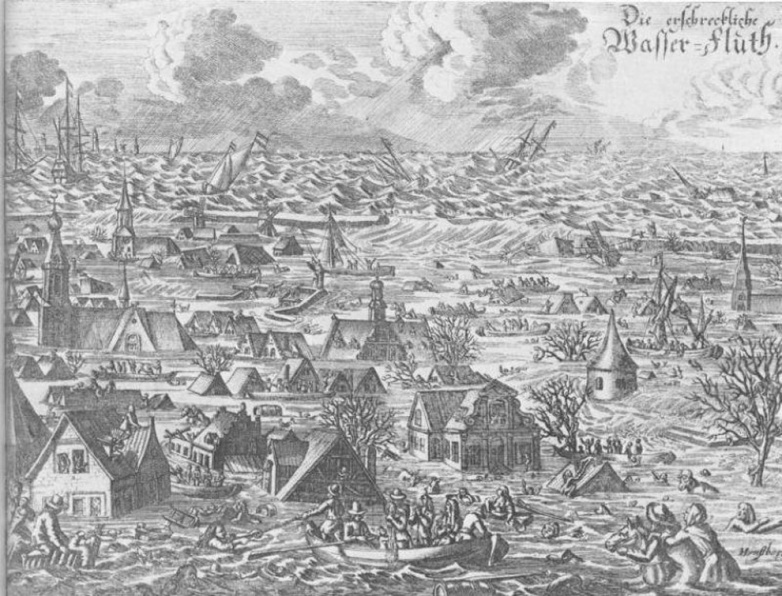
According to various estimates, from 8 to 15 thousand people died during the flood.
Maps of North Friesland in 1651 (left) and 1240 (right): 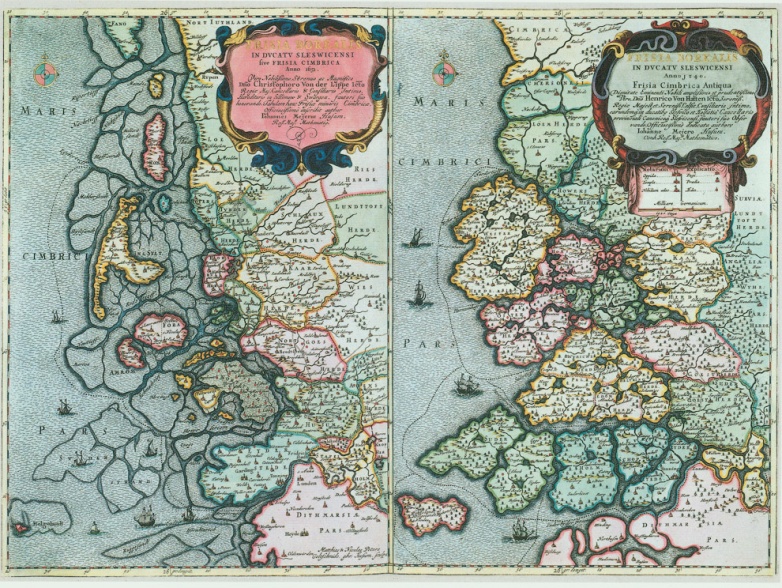
6. Flood of St. Mary Magdalene, 1342
Several thousand. In July 1342, on the feast day of the Myrrh-Bearer Mary Magdalene (the Catholic and Lutheran churches celebrate it on July 22), the largest recorded flood in Central Europe occurred.
On this day, the overflowing waters of the rivers Rhine, Moselle, Main, Danube, Weser, Werra, Unstrut, Elbe, Vltava and their tributaries flooded the surrounding lands. Many cities, such as Cologne, Mainz, Frankfurt am Main, Würzburg, Regensburg, Passau and Vienna, were seriously damaged.
Danube River in Regensburg, Germany: 
According to researchers of this disaster, a long hot and dry period was followed by heavy rains that fell for several days in a row. As a result, about half of the average annual precipitation fell. And since the extremely dry soil could not quickly absorb such an amount of water, surface runoff flooded large areas of the territory. Many buildings were destroyed and thousands of people died. Although the total number of deaths is unknown, it is believed that about 6 thousand people drowned in the Danube region alone.
Besides, summer next year It was wet and cold, so the population was left without crops and suffered greatly from hunger. And on top of everything else, the plague pandemic, which passed through Asia, Europe, North Africa and the island of Greenland (Black Death) in the mid-14th century, reached its peak in 1348-1350, taking the lives of at least a third of the population of Central Europe.
Also see the articles “The 10 Largest Meteorites That Fell to Earth” and “The Seven Great Conquests of Man.”
Illustration of the Black Death, 1411: 
As is known, the most big floods happened in the world 189 years ago in St. Petersburg. We invite you to read about him and others below.
1. 1824 St. Petersburg flood
November 19, 1824 There was a flood in St. Petersburg. It claimed hundreds of lives and destroyed large number houses. The water level in the Neva River and its numerous canals rose by approximately 4.14 - 4.21 m above normal. Approximately 200-600 people died. Before the terrible flood began, it was raining and a very damp and piercing wind was blowing. By evening the city was suddenly flooded. The flood did not reach only the Liteinaya, Karetnaya and Rozhdestvenskaya zones of St. Petersburg.
2. 1931 Flood in China
From 1928 to 1930, as is known, China suffered from severe drought. However, towards the end of the winter of 1930, terrible snowstorms began, and in the spring, torrential, incessant rains suddenly began. For this reason, the water level in the Huaihe and Yangtze rivers has increased excessively. The result was a flood and about 145 thousand - 4 million dead.
3. 1887 and 1938 Flood on the Yellow River.
In 1887, there were torrential rains in Henan province, and as a result, on September 28, the water broke through the dams. Soon the current reached the city of Zhengzhou, and then spread throughout northern China, occupying about 130 thousand sq. km. The flood left about 2 million people homeless and claimed the lives of approximately 900 thousand people.
4. 1530 Saint Felix Flood
On Saturday, November 5, 1530, on a special day - the day of St. Felix de Valois, most of Flanders, the historical region of the Netherlands, and several provinces of Zealand were washed away by water. At least 100 thousand people died. Subsequently, this day began to be called Evil Saturday.
5. 1634 Burchardi flood
On the night of October 11-12, 1634. Due to the storm surge of huge amounts of water caused by strong hurricane winds, terrible flooding occurred in Denmark and Germany. The dams broke and water flooded all coastal communities and cities in North Friesland. Approximately 8-15 thousand people died.
A painting that depicts the Burchardi flood:
6. 1342 Flood of St. Mary Magdalene
In July 1342, on the day of remembrance of the well-known myrrh-bearer Mary Magdalene (Lutheran and Catholic Church celebrate this day on July 22) the worst flood in Central Europe occurred.
Join us on
Floods and other elements have screamed their power since the beginning of time. Often, not only the creations of human hands, but also the people themselves were under their destructive influence. For many centuries in a row, humanity suffered from floods and floods of various scales, which deprived people not only of housing and a roof over their heads, but also of life. Very often people are not ready for such tests and the elements bring a large number of victims, but those who managed to cope with the cataclysm and survive such a terrible disaster once again confirm how brave and strong a person can be morally and physically. During the heavy rainy season, you begin to think about how much trouble water can bring. A person cannot predict when the next flood will occur and what damage it will cause, but he can remember the terrifying pages of history that “drowned” in the water.
1. Such natural disasters have happened in Russia, in particular, one of the most known floods- in St. Petersburg. In total, the cultural capital of the Russian Federation has experienced dozens of major floods, but the worst and most famous one dates back to 1824. A little less than two hundred years ago, due to a rise in the water level in the Neva by more than four meters, according to various sources, from 200 to 600 thousand citizens died, and the damage amounted to up to 20 million rubles. They say that before the river flooded, heavy, continuous rain began, which led to a sharp rise in water. As a result, countless homes, buildings and other objects were destroyed and flooded. To this day, more than twenty signs with water level marks have been preserved throughout the city in memory of many floods; in total there are about 330 of them in St. Petersburg.

2. The St. Mary Magdalene flood of 1342 is considered the worst disaster in Central Europe. Heavy torrential rains, lasting for several days in a row, led to an increase in water levels in several rivers at once: the Rhine, Weser, Main, Moselle, Werre, Elbe and more. Water flooded the surroundings of such large European cities as Cologne, Passau, Vienna, Regensburg, Frankfurt am Main. The exact number of victims is not known, however, it is assumed that their number is at least several thousand.
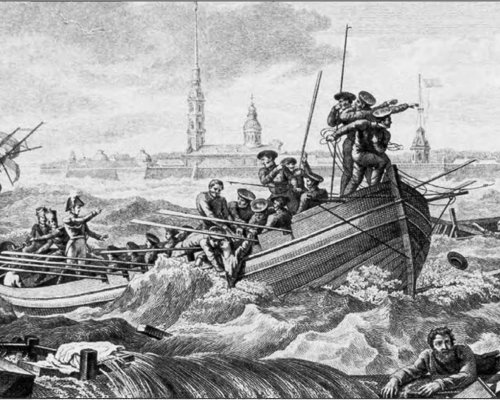
3. The flood of 1534 in Denmark and Germany, called the Burchardi flood, claimed more than eight thousand lives. Here, the cause of the cataclysm was a strong hurricane wind, which led to a storm surge of water and a dam breach in several places and the North Sea coast. The communities of North Frisia and many coastal towns were flooded.
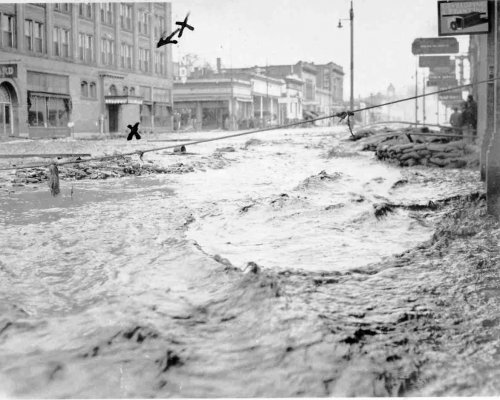
4. One of the most famous and largest rivers in China, the Yellow River is famous for its arbitrary and capricious “temper” and frequent floods; its waters have repeatedly brought tragedy to many homes, and the number of victims amounts to millions of families. The largest spills were recorded in 1887 and 1938, when about 900 and 500 thousand people died, respectively. But if in the first case the floods followed multiple dam breaks after prolonged rains, then in the second the disaster was provoked by the nationalist government in order to stop the advance of Japanese troops. Millions of people were forced to leave their homes to escape, and dozens of entire villages and thousands of hectares of agricultural land were under water.
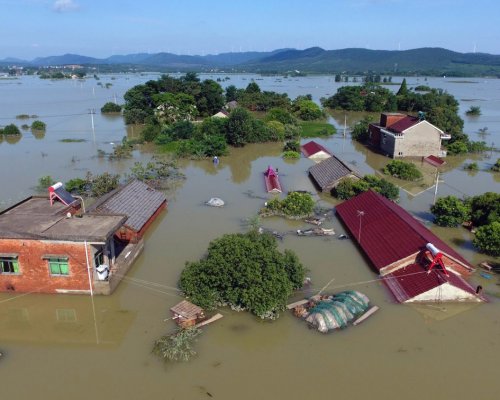
5. As for the cataclysms of the last century, historians note, again, China. In 1934, the Yangtze River overflowed its banks, taking with it the lives of an estimated four million people. After the Flood, this is considered the most catastrophic and large-scale natural phenomenon. As a result of the flood, four million houses and three hundred thousand square meters were flooded. kilometers of land.
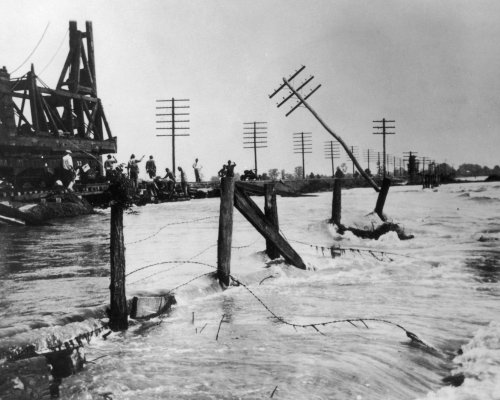
6. The 1927 flood in America is called the “Great Flood.” After prolonged heavy rains, the Mississippi River overflowed, flooding an area of ten states. In some places, the water reached a height of ten meters and the government decided to blow up a dam near the city to avoid flooding of New Orleans, which led to further flooding in other areas. According to various estimates, about half a million people died as a result of the flood.
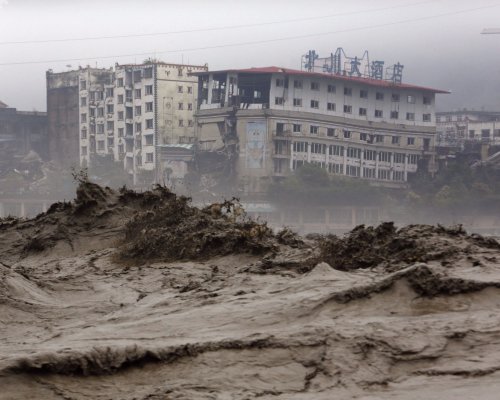
7. One of the most terrible floods on the territory of modern Holland is the Zeeland disaster of 1953. It was caused by the coincidence of a spring tide and a strong storm. And although the local residents were calm, because for many years they had paid enough attention to protection from natural disasters and were confident that the constructed structures would protect them from any storm, they could not avoid the sad consequences. At a speed of 150 kilometers per hour, billions of cubic meters of water rushed onto the land; in the blink of an eye, the raging sea reached the roofs of the tallest city buildings, wiping out more than 130 settlements along the way. The damage was estimated at millions of guilders, only 7 thousand people were evacuated, about two thousand local residents died as a result of the flooding, and many were missing.
10. One of the most destructive natural disasters of our days is considered to be the tsunami in the Indian Ocean, which subsequently affected the coasts of Indonesia, South India, Sri Lanka and Thailand. The underwater earthquake generated a powerful tsunami, the number of victims is estimated at 230 thousand people.
Oksana Lugovaya
189 years ago, the largest flood in the history of St. Petersburg occurred. To commemorate this event, we cover it and other of the world's deadliest floods.
1. St. Petersburg flood, 1824
About 200-600 dead. On November 19, 1824, a flood occurred in St. Petersburg, which killed hundreds of people and destroyed many houses. Then the water level in the Neva River and its canals rose 4.14 - 4.21 meters above the normal level (ordinary).
Memorial plaque on the Raskolnikov House:
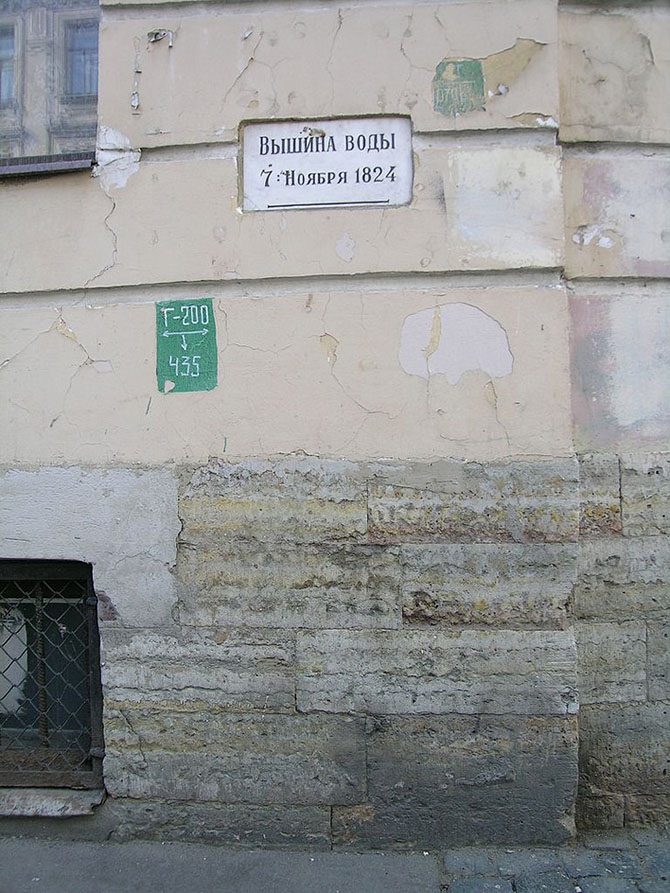
Before the flood began, it was raining and a damp and cold wind was blowing in the city. And in the evening there was a sharp rise in the water level in the canals, after which almost the entire city was flooded. The flood did not affect only the Liteinaya, Rozhdestvenskaya and Karetnaya parts of St. Petersburg. As a result, material damage from the flood amounted to about 15-20 million rubles, and about 200-600 people died.
One way or another, this is not the only flood that occurred in St. Petersburg. In total, the city on the Neva was flooded more than 330 times. In memory of many floods in the city, memorial plaques have been installed (there are more than 20 of them). In particular, a sign is dedicated to the largest flood in the city, which is located at the intersection of the Kadetskaya Line and Bolshoy Prospekt of Vasilievsky Island.
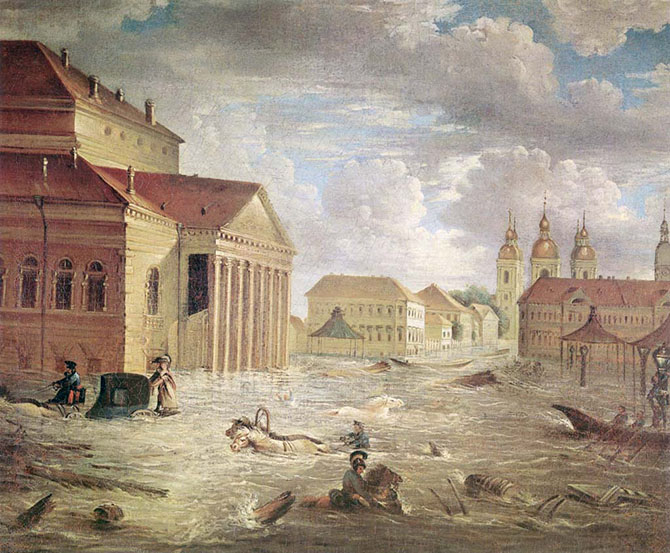
Interestingly, before the founding of St. Petersburg, the largest flood in the Neva delta occurred in 1691, when this territory was under the control of the Kingdom of Sweden. This incident is mentioned in Swedish chronicles. According to some reports, that year the water level in the Neva reached 762 centimeters.
2. Flood in China, 1931
About 145 thousand - 4 million dead. From 1928 to 1930, China suffered from severe drought. But at the end of the winter of 1930, strong snowstorms began, and in the spring there were incessant heavy rains and a thaw, which caused the water level in the Yangtze and Huaihe rivers to rise significantly. For example, in the Yangtze River the water rose by 70 cm in July alone.
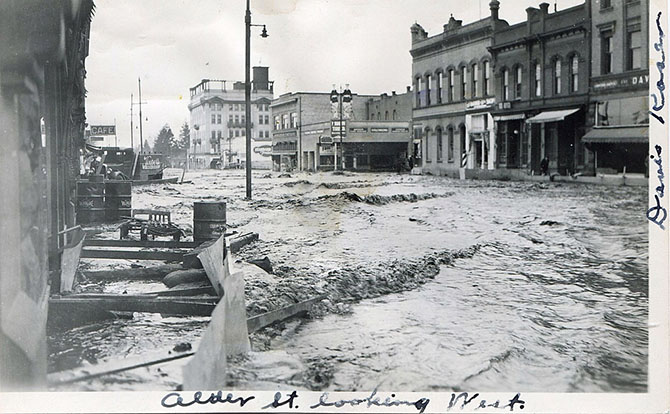
As a result, the river overflowed its banks and soon reached the city of Nanjing, which was at that time the capital of China. Many people drowned and died from waterborne infectious diseases such as cholera and typhus. There are known cases of cannibalism and infanticide among desperate residents.
According to Chinese sources, about 145 thousand people died as a result of the flood, while Western sources claim that the death toll was between 3.7 million and 4 million.
By the way, this was not the only flood in China caused by the waters of the Yangtze River overflowing its banks. Floods also occurred in 1911 (about 100 thousand people died), in 1935 (about 142 thousand people died), in 1954 (about 30 thousand people died) and in 1998 (3,656 people died). It is considered the largest natural disaster in recorded human history.
Flood victims, August 1931:
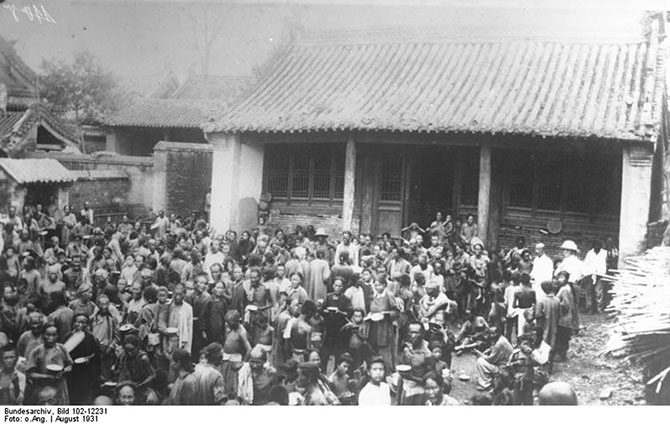
3. Yellow River Flood, 1887 and 1938
About 900 thousand and 500 thousand died, respectively. In 1887, heavy rains fell for many days in Henan Province, and on September 28, rising water in the Yellow River broke the dams. Soon the water reached the city of Zhengzhou, located in this province, and then spread across the entire northern part of China, covering approximately 130,000 sq. km. Due to the flood, about two million people in China were left homeless, and approximately 900 thousand people died.
And in 1938, a flood on the same river was caused by the Nationalist government in Central China at the beginning of the Sino-Japanese War. This was done in order to stop Japanese troops rapidly advancing into central China. The flood was subsequently called "the largest act of environmental warfare in history."
Thus, in June 1938, the Japanese took control of the entire northern part of China, and on June 6 they captured Kaifeng, the capital of Henan Province, and threatened to capture Zhengzhou, which was located near the intersection of the important Beijing-Guangzhou and Lianyungang-Xi'an railways. If the Japanese army had managed to do this, major Chinese cities such as Wuhan and Xi'an would have been under threat.
In order to prevent this, the Chinese government in Central China decided to open dams on the Yellow River near the city of Zhengzhou. Water flooded the provinces of Henan, Anhui and Jiangsu adjacent to the river.
Soldiers of the National Revolutionary Army during the flood on the Yellow River in 1938:
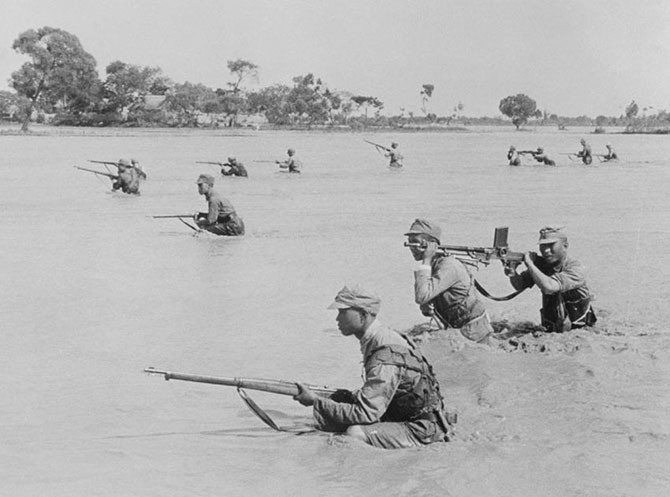
The floods destroyed thousands of square kilometers of farmland and many villages. Several million people became refugees. According to initial data from China, about 800 thousand people drowned. However, these days, researchers studying the archives of the disaster claim that much fewer people died - about 400 - 500 thousand.
Yellow River Yellow River:
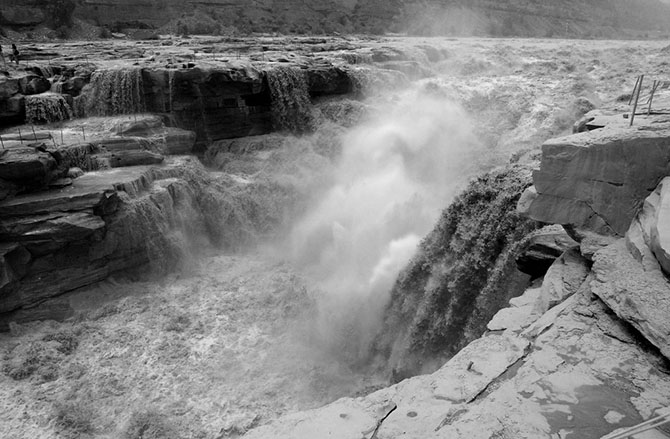
Interestingly, the value of this Chinese government strategy has been questioned. Because according to some reports, Japanese troops at that time were far from the flooded areas. Although their advance on Zhengzhou was thwarted, the Japanese took Wuhan in October.
4. Flood of St. Felix, 1530
At least 100 thousand dead. On Saturday, November 5, 1530, the day of Saint Felix de Valois, most of Flanders, the historical region of the Netherlands, and the province of Zealand were washed away. Researchers believe that more than 100 thousand people died. Subsequently, the day when the disaster occurred began to be called Evil Saturday.
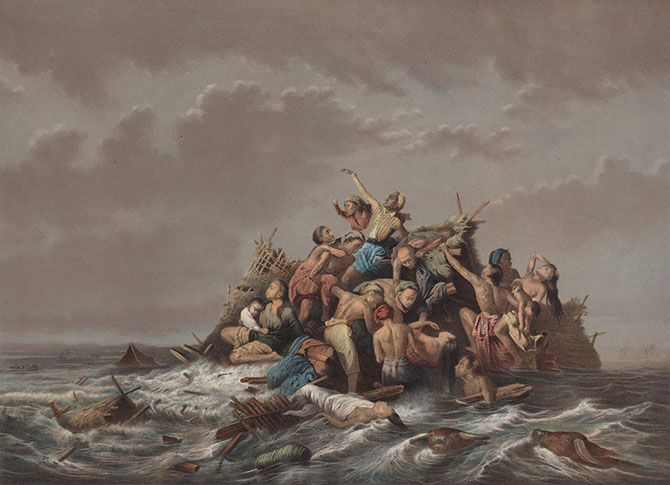
5. Burchardi flood, 1634
About 8-15 thousand dead. On the night of October 11–12, 1634, flooding occurred in Germany and Denmark as a result of a storm surge caused by hurricane winds. That night, dams broke in several places along the North Sea coast, flooding coastal towns and communities in North Friesland.
Painting depicting the Burchardi flood:
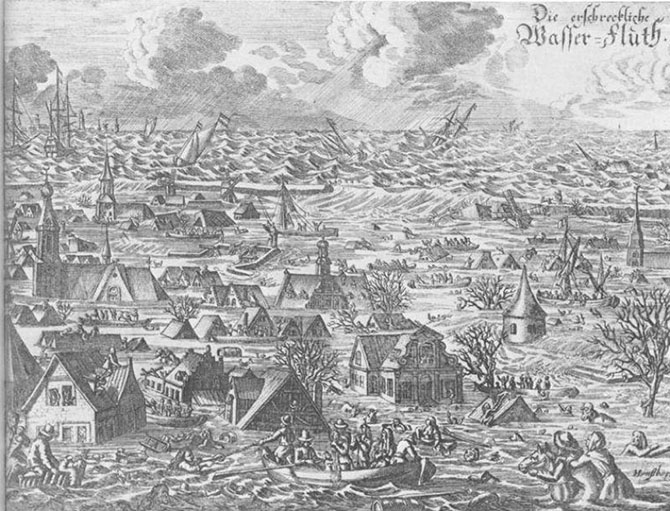
According to various estimates, from 8 to 15 thousand people died during the flood.
Maps of North Friesland in 1651 (left) and 1240 (right):
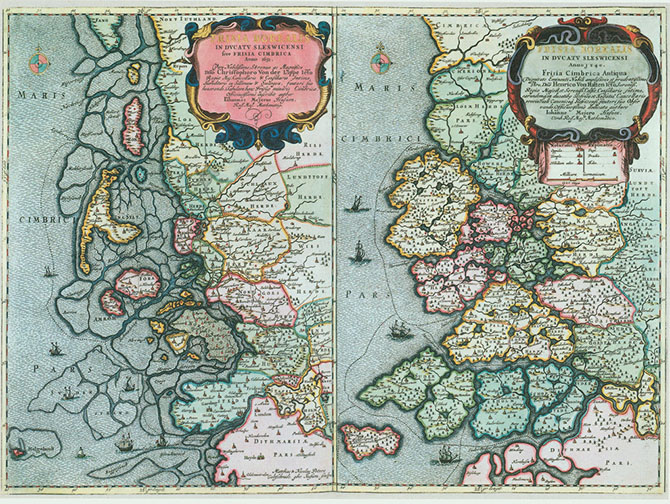
6. Flood of St. Mary Magdalene, 1342
Several thousand. In July 1342, on the feast day of the Myrrh-Bearer Mary Magdalene (the Catholic and Lutheran churches celebrate it on July 22), the largest recorded flood in Central Europe occurred.
On this day, the overflowing waters of the rivers Rhine, Moselle, Main, Danube, Weser, Werra, Unstrut, Elbe, Vltava and their tributaries flooded the surrounding lands. Many cities, such as Cologne, Mainz, Frankfurt am Main, Würzburg, Regensburg, Passau and Vienna, were seriously damaged.
Danube River in Regensburg, Germany:
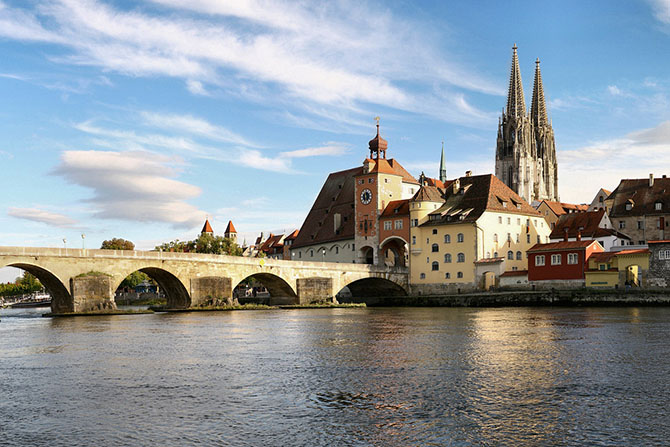
According to researchers of this disaster, a long hot and dry period was followed by heavy rains that fell for several days in a row. As a result, about half of the average annual precipitation fell. And since the extremely dry soil could not quickly absorb such an amount of water, surface runoff flooded large areas of the territory. Many buildings were destroyed and thousands of people died. Although the total number of deaths is unknown, it is believed that about 6 thousand people drowned in the Danube region alone.
In addition, the summer of the following year was wet and cold, so the population was left without crops and suffered greatly from hunger. And on top of everything else, the plague pandemic, which passed through Asia, Europe, North Africa and the island of Greenland (Black Death) in the mid-14th century, reached its peak in 1348-1350, taking the lives of at least a third of the population of Central Europe.
Illustration of the Black Death, 1411:
